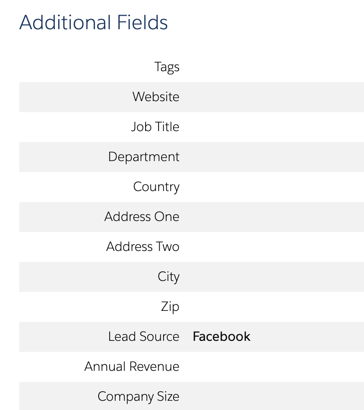Refreshed and republished on May 6, 2021
This post was originally published on October 19, 2015 and has been revamped and updated for accuracy and comprehensiveness.
Lead source is an important data point you need to capture in order to report on the value of your marketing campaigns. This article will walk you through how to setup and track lead source within Pardot.
Where to find the Lead Source field in Pardot
The lead source field is a default field in Pardot and can be synced with Salesforce. The field can be found on the prospect’s record under additional fields.
How a prospect’s source is populated
The prospect’s source field is determined by the referring URL. The referring URL is the page the visitor was on before visiting a page. The page must have the Pardot tracking code embedded to pull in the referring URL.
For example, if a prospect’s referring URL is www.linkedin.com/profile/JennaMolby and no UTM parameters exist, Pardot populates the prospect’s source field as LinkedIn.
Here are some values that can appear in the source field:
|
|
The default sources can be extremely useful since it’s not likely all your links will have source parameters. However, try to use custom sources where you can.
How to create custom sources
To create custom lead sources in Pardot, you will need to use URL parameters in you landing page links. Pardot looks for the parameter utm_source within your URL. This will override the default Pardot lead sources, so you can use both to track lead source.
URL example
https://www.jennamolby.com/MyLandingPage.html?utm_source=Webinar
The parameter can be whatever you want, but try to have a standard way of defining your lead sources for better reporting. Here are some common lead source values:
- List Upload
- Partner
- Referral
- Phone Inquiry
- Cold Call
- Tradeshow
- Webinar
- Whitepaper
- Website
Maunually set the source field value
You can manually set the source field value by using imports, automation rules, completion actions, segmentation rules, and engagement programs.
This Pardot article written by:
Jenna Molby
Jenna is a Salesforce Certified Pardot Specialist, Salesforce Certified Pardot Consultant and Salesforce Marketing Champion 2020. Jenna is a marketing operations leader with over ten years of B2B and B2C experience working on both the agency and client-side.
Original Pardot Article: https://jennamolby.com/how-to-capture-lead-source-in-pardot/
Find more great Pardot articles at https://jennamolby.com/
Pardot Experts Blog
We have categorized all the different Pardot articles by topics.
Pardot Topic Categories
- Account Based Marketing (ABM) (7)
- Business Units (14)
- ChatGPT / AI (3)
- Completion Actions (5)
- Connectors (10)
- Custom Redirects (4)
- Data Cloud (3)
- Demand Generation (8)
- Dynamic Content (7)
- Einstein Features (11)
- Email Delivery (17)
- Email Open Rates (3)
- Pardot A/B Testing (2)
- Email Mailability (16)
- Do Not Email (1)
- Double Opt-in (2)
- Opt Out / Unsubscribe (14)
- Email Preferences Page (6)
- Engagement Studio (16)
- Industries (1)
- Non Profit (1)
- Landing Pages (9)
- Lead Generation (1)
- Lead Management (13)
- Lead Routing (3)
- Lead Scoring (16)
- Leads (3)
- Marketing Analytics – B2BMA (9)
- Marketing Automation (1)
- Marketing Cloud (3)
- Marketing Cloud Account Engagement (4)
- Marketing Cloud Growth (2)
- New Pardot Features (6)
- Opportunities (2)
- Optimization (2)
- Pardot Admin (65)
- Duplicates (1)
- Marketing Ops (1)
- Pardot Alerts (1)
- Pardot API (2)
- Pardot Automations (3)
- Pardot Careers (12)
- Pardot Certifications (4)
- Pardot Consulting (1)
- Pardot Cookies (4)
- Pardot Custom Objects (3)
- Pardot Email Builder (8)
- Pardot Email Templates (10)
- HML (6)
- Pardot Events (17)
- Pardot External Actions (1)
- Pardot External Activities (4)
- Pardot Forms (29)
- Form Handlers (8)
- Pardot Integrations (21)
- Data Cloud (2)
- Slack (1)
- Pardot Lead Grading (5)
- Pardot Lead Source (2)
- Pardot Lightning (1)
- Pardot Migration (1)
- Pardot Nurture / Drip Campaigns (2)
- Pardot Personalization (3)
- Pardot Profiles (1)
- Pardot Releases (18)
- Pardot Sandboxes (2)
- Pardot Segmentation (5)
- Pardot Strategy (7)
- Pardot Sync (2)
- Pardot Sync Errors (1)
- Pardot Tracker Domains (5)
- Pardot Training (3)
- Pardot Vs Other MAPs (4)
- Pardot Website Tracking (2)
- Reporting (22)
- Salesforce and Pardot (31)
- Marketing Data Sharing (2)
- Pardot Users (3)
- Salesforce Automation (5)
- Salesforce Flows (2)
- Salesforce Campaigns (22)
- Salesforce CRM (3)
- Record Types (1)
- Salesforce Engage (3)
- Salesforce Queues (2)
- Security and Privacy (1)
- Tags (3)
- The Authors (540)
- Cheshire Impact (9)
- Greenkey Digital (55)
- Invado Solutions (37)
- Jenna Molby (9)
- Marcloud Consulting (6)
- Nebula Consulting (67)
- Pardot Geeks (44)
- Salesforce Ben | The Drip (242)
- SalesLabX (16)
- Slalom (4)
- Unfettered Marketing (51)
- Uncategorized (1)
- Website Tracking (2)
- Website Search (1)
More Pardot Articles
See all posts
This Pardot article written by:
Jenna Molby
Jenna is a Salesforce Certified Pardot Specialist, Salesforce Certified Pardot Consultant and Salesforce Marketing Champion 2020. Jenna is a marketing operations leader with over ten years of B2B and B2C experience working on both the agency and client-side.
Original Pardot Article: https://jennamolby.com/how-to-capture-lead-source-in-pardot/
Find more great Pardot articles at https://jennamolby.com/








